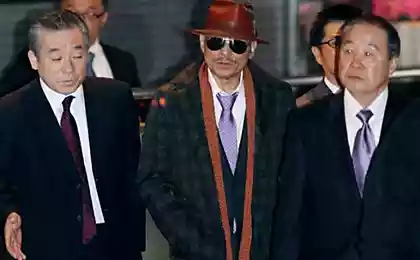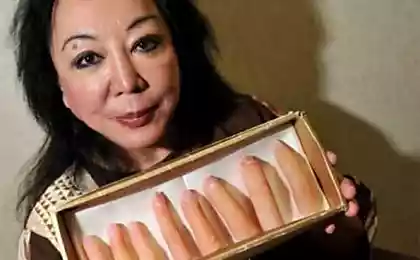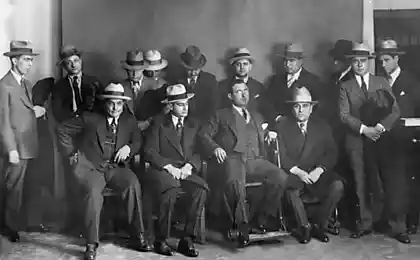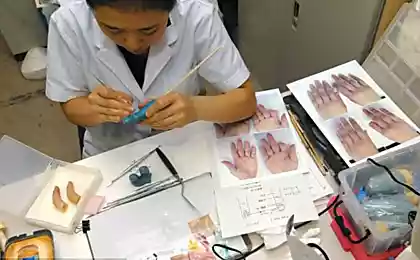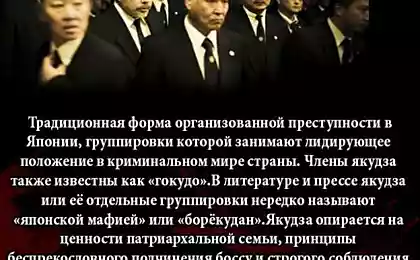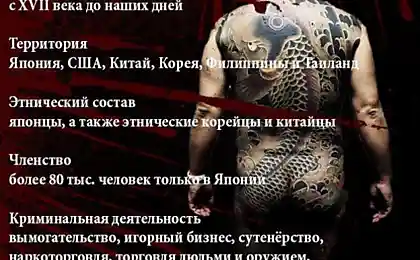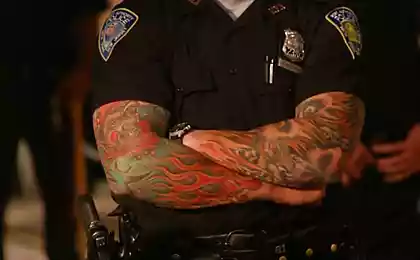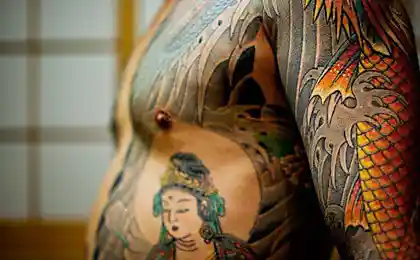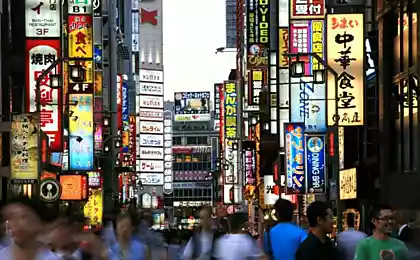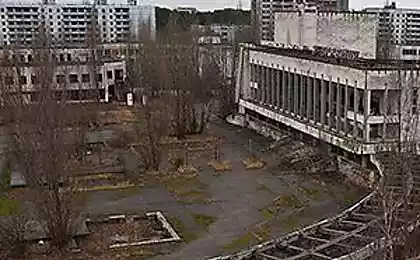1073
Facts about the yakuza
1. Sokayya

Sokayya - the name of the form of large-scale bribery practiced by the Yakuza. First, they buy shares of a company in a sufficient amount to obtain a voice in the council of shareholders. Then members of the yakuza learn as much incriminating facts about the company's management as they can. After that usually begin trading in the style of "or you pay us, or the shareholders' meeting, we something to tell you." In Japanese culture, the fear of stigma is a huge force, so that this tactic usually works.
Really unusual in this scam that everything is carried out with the utmost courtesy. And threats, and payments are made in a roundabout way: for example, the yakuza organize an event like golf tournaments or beauty contest and overpriced sell their blackmail victims tickets. By 1982, the ninth year sokayya reached such proportions that it was necessary to introduce a number of laws prohibiting corporations pay blackmailers. It brought little benefit, and the yakuza had come up with a more elaborate scheme to conceal his actions.
In addition, managers often have to put up with the existence of the yakuza, because they when disclosing information could face prosecution if they are involved in sokayya in the past. The most effective tactic to combat sokayya is to hold shareholders' meetings on the same day across the country, as even members of the yakuza can not be everywhere at once: for example, 90% of corporations on the Tokyo Stock Exchange holds its annual meeting of shareholders in the same day.
2. yakuza crackdown
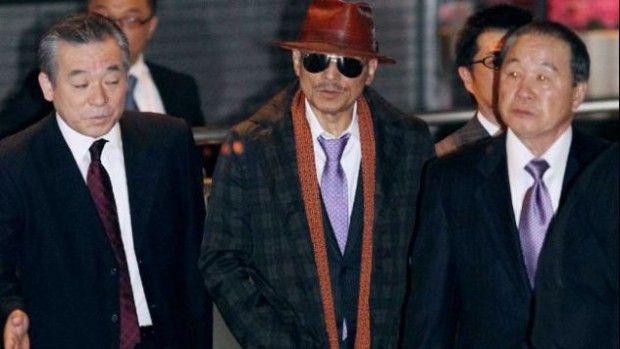
Yamaguchi-gumi - the largest syndicate in Japan. Recently, he became the object of sanctions by the US government to fight organized crime. US citizens are no longer allowed to enter into a deal with the leader of the syndicate Kenichi Synod, his deputy Kiyoshi Takayama also hit the black list, and the US government to freeze all US assets. In this regard, in Japan, there were laws aimed at breaking the link between the yakuza and legitimate business.
Previous attempts to limit the influence of the Japanese Yakuza included introduction of fines for companies that are willing to cooperate with the bandits. These efforts seem to have paid off - the number of representatives of the Yakuza is currently reduced to a record low for the past 50 years.
According to the Synod disappearance Yakuza threatens the emergence of thousands of dangerous criminals unemployed, and if disband Yamaguchi-gumi, the public order will be disturbed instantly.
3. Secondary aid Yakuza
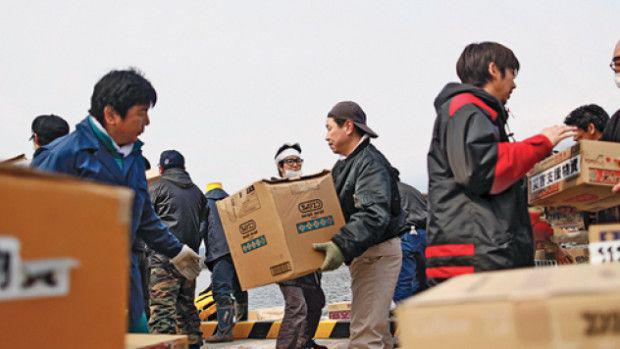
When, in 2011, the year Japan tsunami struck, the yakuza were among the first who rushed to the affected areas to help. It is not unprecedented: in 1995, when the earthquake struck in Kobe, the fifth largest city in Japan, members of the yakuza used scooters, boats and helicopters to deliver supplies to the dilapidated quarters.
Some people believe that the yakuza are always in need of help, if necessary, because most of their members - outcasts of society, sympathetic to people at risk of not getting timely help from the authorities. Others, however, people are more cynical and believe that such behavior - no more than an effective PR: Police difficult to get public support for the fight against the Yakuza after a charity.
Also in such cases, the yakuza can receive substantial financial benefits. A few months after the earthquake in 2011, was owned by the yakuza organizations to compete for government contracts for construction. The scale of the disaster led to the fact that the government could not keep away the Yakuza, the Japanese mafia that more often operates through front companies that are indistinguishable from legitimate. One such contract received yakuza, led to the fact that the head of a shell company to jail - he was seen in the retention of the salaries to workers for profit, and believed that it will cover the yakuza.
4. Journal Yakuza
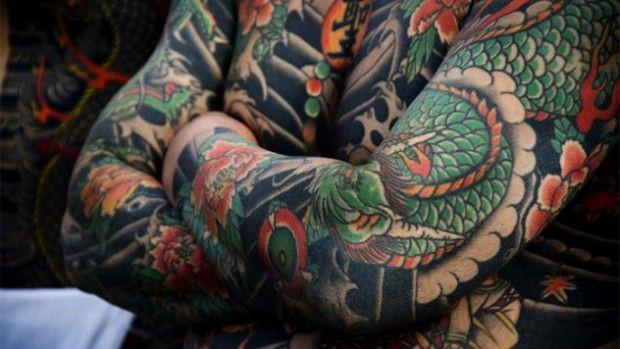
This year, the Yamaguchi-gumi newsletters distributed to almost all 28 thousand members. The magazine called "Yamaguchi-gumi Shinpo" were, among other things, haiku and articles about fishing. Also, the editors on behalf of the head of the syndicate were talking about hard times for the organization. At this time, the yakuza were really difficult, and the magazine became a way to raise morale.
However, some copies of the magazine were in the hands of civilians. Experts believe that, despite the fact that the magazine is distributed to members of the syndicate Yakuza know that hearing about this leak and outside the organization. Thus, the creation of a cultural magazine was to weaken the link between the Yamaguchi-gumi, and violence in the public consciousness.
5. Yubitsume
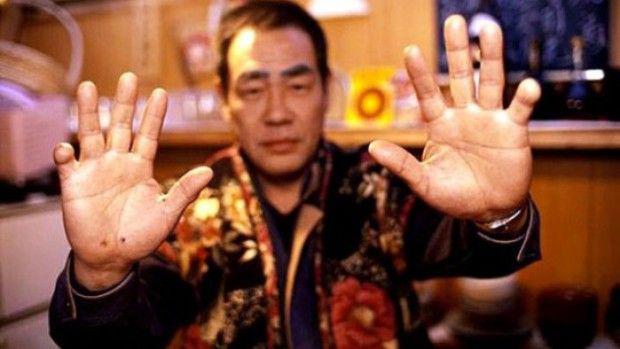
The members of the yakuza, seen in terms of improper actions Yakuza must redeem himself by cutting off part of his own finger - the ritual known as yubitsume. For the first offense rather cut off his little finger tip, but subsequent offenses are fraught with more serious injuries. As a result, many members of the organization partially or completely missing the little finger of the left, and in some cases - and the other fingers.
This has led to strong demand for artificial fingers. Missing fingers are a kind of blot, and their lack of hiding is difficult, but necessary, as most Japanese are aware of this ritual. Professor Alan Roberts (Alan Roberts), an expert on the skin from the UK, Japan exported a lot of realistic prosthesis that among the former Yakuza earn the nickname "Mr. Finger».
6. Tattoos
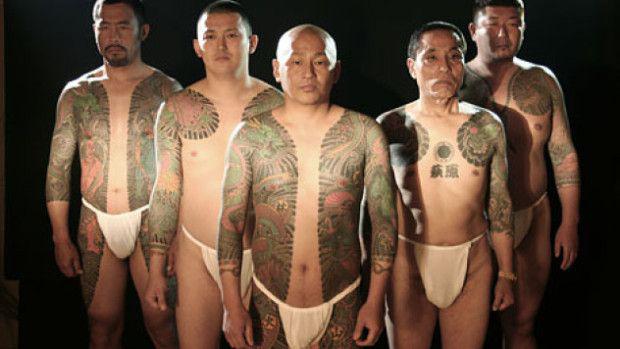
One of the iconic images of the Yakuza are their intricate color tattoos all over his body. Yakuza use the traditional method of manually entering the ink under the skin, known as irezumi - this tattoo serves as a proof of courage, because this method is very painful. In recent years, increased the popularity of this style, and among non-yakuza. The most popular patterns are usually composed of dragons, mountains and women.
Despite the trend of tattoos spread among non-yakuza, these signs in Japanese society still show it to the members of the syndicate. Osaka mayor imposed a ban on such tattoos for civil servants by asking them to make a tattoo, or to look for work elsewhere.
7.Yakudza court
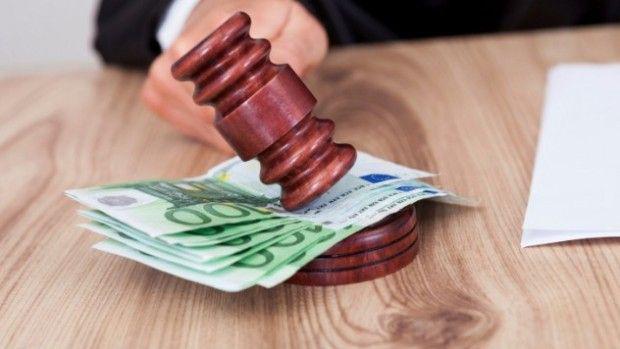
This year, the owner of the restaurant from the beginning of the trial Kenichi Synod - thus extremely dangerous head of a crime syndicate Yamaguchi-gumi, which we have already mentioned. She claimed that the Synod is responsible for his people, who demanded from it protection money, and threatened to burn her restaurant if she did not pay. So it is in court to claim damages in the amount of 17 million yen, or about $ 2, 8 million.
She - not the first person who has submitted to the yakuza in court. In 2008, a group of residents filed a lawsuit to evict a gang Doinkai from their headquarters in the city of Kurume. The group broke up after a dispute over the leadership, which led to a brutal war between the two sides. Residents claimed that deserve to live in peace, so that insisted on leaving the gang out of their city.
But the yakuza are not always the defendants. Earlier this year, Kudo-kai yakuza syndicate in southern Japan, was named the law enforcement agencies "dangerous" - they were involved in a series of attacks on the headquarters of the syndicate of another grenade. Lawyer Kudo-kai said that the similar characteristics of the syndicate at least unfair because Kudo-kai - only one of the five competing syndicates in the south of the country, and the status was granted only to them, so that there is a violation of the Constitution of Japan.
8. Examinations
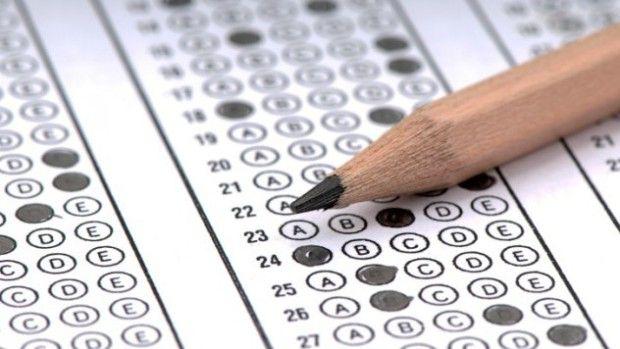
In 2009, the Yamaguchi-gumi created a 12-page examination of its members. This step was taken after the government passed tough laws against organized crime. The exams were positioned as an attempt to protect the members of the syndicate of trouble and make sure they know the laws. Questions in the questionnaire dealt with a variety of topics - from waste disposal to vehicle theft.
Although the idea of tattooed gangsters sitting in the examination room after a day of cramming may seem amusing, delivery of these tests gives an idea of the Japanese economy as a whole. Yakuza have long been a barometer of the economy and culture: if you already bandits believe that it is a hard time, and do everything possible to reduce the losses to a minimum, and the rest are in the same position.
9. The ritual initiation
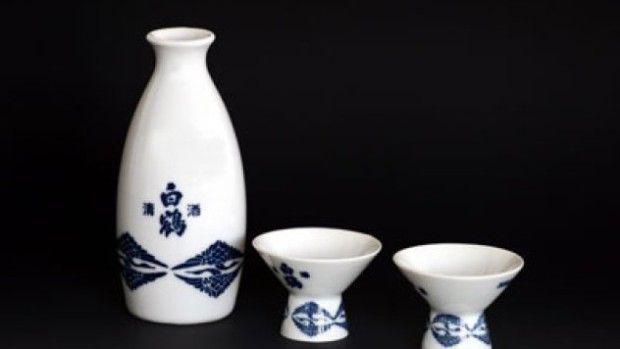
Converts yakuza underlings are forced to be more experienced members. They are called kobun, in a literal translation - "the role of the child." Over the years, the yakuza has developed a complex management structure, and the need to overcome a lot of steps to reach the top.
The basis for the novice initiation ritual is based on the sake ceremony called sakazukigoto. The initiate sits in front of his Oyabun - member of the group performing the "father figure", and others are preparing a drink. Junior gets a smaller share of the beverage, while the bowl of his "teacher" is filled to the brim, reflecting its status. Each sips from the cup, after which they are exchanged, and then ends the ceremony. This ritual means creating links between kobunom and Oyabun similar to the adoptive relationship of father and son.
Drinking sake ceremony is traditionally used in Japanese culture to create a connection. Sake is seen as a link between people and the gods, deriving from the divine blessings of a good harvest, and this relationship can strengthen the relationship between people. This gives the historicity of the religious significance of the initiation ceremony, the venue for the ceremony, so often a Japanese Shinto shrine.
10. Yakuza politics
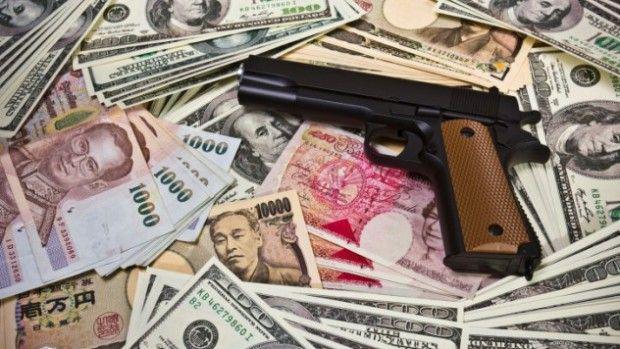
In 2012, the Minister of Justice of Japan Keisha Tanaka was forced to resign, as it became known about his connection with the Yakuza. However, such links were not always so undesirable for Japanese politicians.
The Liberal Democratic Party (LDP), which manages Japan for 54 years of the last 58 years, often cooperated with the Yakuza. The first LDP prime minister Nobusuke Kishi worked closely with the Yamaguchi-gumi: in 1971, he and other politicians made a deposit for the leader of the Yamaguchi-gumi, convicted of murder. He also participated in the weddings and funerals of members of the yakuza.
During the election, members of the yakuza often act as bodyguards and agitators. In addition, the yakuza gangs are able to provide a certain number of votes their favorite candidates. The head of a yakuza gang in Kyoto claimed that he was able to provide 30,000 votes to elect the governor particular.
At least four other prime minister had links with the yakuza, including those who came to power in 1987, Noboru Takeshita. Shortly before the election, he faced persecution by the right-wing opponents, therefore appealed for support to the largest yakuza group in Tokyo - Inagawa-kai. Of course, they have eliminated the problem, but in the end there was a lot of speculation about how feels comfortable ruling elite of Japan under the auspices of organized crime.

Sokayya - the name of the form of large-scale bribery practiced by the Yakuza. First, they buy shares of a company in a sufficient amount to obtain a voice in the council of shareholders. Then members of the yakuza learn as much incriminating facts about the company's management as they can. After that usually begin trading in the style of "or you pay us, or the shareholders' meeting, we something to tell you." In Japanese culture, the fear of stigma is a huge force, so that this tactic usually works.
Really unusual in this scam that everything is carried out with the utmost courtesy. And threats, and payments are made in a roundabout way: for example, the yakuza organize an event like golf tournaments or beauty contest and overpriced sell their blackmail victims tickets. By 1982, the ninth year sokayya reached such proportions that it was necessary to introduce a number of laws prohibiting corporations pay blackmailers. It brought little benefit, and the yakuza had come up with a more elaborate scheme to conceal his actions.
In addition, managers often have to put up with the existence of the yakuza, because they when disclosing information could face prosecution if they are involved in sokayya in the past. The most effective tactic to combat sokayya is to hold shareholders' meetings on the same day across the country, as even members of the yakuza can not be everywhere at once: for example, 90% of corporations on the Tokyo Stock Exchange holds its annual meeting of shareholders in the same day.
2. yakuza crackdown

Yamaguchi-gumi - the largest syndicate in Japan. Recently, he became the object of sanctions by the US government to fight organized crime. US citizens are no longer allowed to enter into a deal with the leader of the syndicate Kenichi Synod, his deputy Kiyoshi Takayama also hit the black list, and the US government to freeze all US assets. In this regard, in Japan, there were laws aimed at breaking the link between the yakuza and legitimate business.
Previous attempts to limit the influence of the Japanese Yakuza included introduction of fines for companies that are willing to cooperate with the bandits. These efforts seem to have paid off - the number of representatives of the Yakuza is currently reduced to a record low for the past 50 years.
According to the Synod disappearance Yakuza threatens the emergence of thousands of dangerous criminals unemployed, and if disband Yamaguchi-gumi, the public order will be disturbed instantly.
3. Secondary aid Yakuza

When, in 2011, the year Japan tsunami struck, the yakuza were among the first who rushed to the affected areas to help. It is not unprecedented: in 1995, when the earthquake struck in Kobe, the fifth largest city in Japan, members of the yakuza used scooters, boats and helicopters to deliver supplies to the dilapidated quarters.
Some people believe that the yakuza are always in need of help, if necessary, because most of their members - outcasts of society, sympathetic to people at risk of not getting timely help from the authorities. Others, however, people are more cynical and believe that such behavior - no more than an effective PR: Police difficult to get public support for the fight against the Yakuza after a charity.
Also in such cases, the yakuza can receive substantial financial benefits. A few months after the earthquake in 2011, was owned by the yakuza organizations to compete for government contracts for construction. The scale of the disaster led to the fact that the government could not keep away the Yakuza, the Japanese mafia that more often operates through front companies that are indistinguishable from legitimate. One such contract received yakuza, led to the fact that the head of a shell company to jail - he was seen in the retention of the salaries to workers for profit, and believed that it will cover the yakuza.
4. Journal Yakuza

This year, the Yamaguchi-gumi newsletters distributed to almost all 28 thousand members. The magazine called "Yamaguchi-gumi Shinpo" were, among other things, haiku and articles about fishing. Also, the editors on behalf of the head of the syndicate were talking about hard times for the organization. At this time, the yakuza were really difficult, and the magazine became a way to raise morale.
However, some copies of the magazine were in the hands of civilians. Experts believe that, despite the fact that the magazine is distributed to members of the syndicate Yakuza know that hearing about this leak and outside the organization. Thus, the creation of a cultural magazine was to weaken the link between the Yamaguchi-gumi, and violence in the public consciousness.
5. Yubitsume

The members of the yakuza, seen in terms of improper actions Yakuza must redeem himself by cutting off part of his own finger - the ritual known as yubitsume. For the first offense rather cut off his little finger tip, but subsequent offenses are fraught with more serious injuries. As a result, many members of the organization partially or completely missing the little finger of the left, and in some cases - and the other fingers.
This has led to strong demand for artificial fingers. Missing fingers are a kind of blot, and their lack of hiding is difficult, but necessary, as most Japanese are aware of this ritual. Professor Alan Roberts (Alan Roberts), an expert on the skin from the UK, Japan exported a lot of realistic prosthesis that among the former Yakuza earn the nickname "Mr. Finger».
6. Tattoos

One of the iconic images of the Yakuza are their intricate color tattoos all over his body. Yakuza use the traditional method of manually entering the ink under the skin, known as irezumi - this tattoo serves as a proof of courage, because this method is very painful. In recent years, increased the popularity of this style, and among non-yakuza. The most popular patterns are usually composed of dragons, mountains and women.
Despite the trend of tattoos spread among non-yakuza, these signs in Japanese society still show it to the members of the syndicate. Osaka mayor imposed a ban on such tattoos for civil servants by asking them to make a tattoo, or to look for work elsewhere.
7.Yakudza court

This year, the owner of the restaurant from the beginning of the trial Kenichi Synod - thus extremely dangerous head of a crime syndicate Yamaguchi-gumi, which we have already mentioned. She claimed that the Synod is responsible for his people, who demanded from it protection money, and threatened to burn her restaurant if she did not pay. So it is in court to claim damages in the amount of 17 million yen, or about $ 2, 8 million.
She - not the first person who has submitted to the yakuza in court. In 2008, a group of residents filed a lawsuit to evict a gang Doinkai from their headquarters in the city of Kurume. The group broke up after a dispute over the leadership, which led to a brutal war between the two sides. Residents claimed that deserve to live in peace, so that insisted on leaving the gang out of their city.
But the yakuza are not always the defendants. Earlier this year, Kudo-kai yakuza syndicate in southern Japan, was named the law enforcement agencies "dangerous" - they were involved in a series of attacks on the headquarters of the syndicate of another grenade. Lawyer Kudo-kai said that the similar characteristics of the syndicate at least unfair because Kudo-kai - only one of the five competing syndicates in the south of the country, and the status was granted only to them, so that there is a violation of the Constitution of Japan.
8. Examinations

In 2009, the Yamaguchi-gumi created a 12-page examination of its members. This step was taken after the government passed tough laws against organized crime. The exams were positioned as an attempt to protect the members of the syndicate of trouble and make sure they know the laws. Questions in the questionnaire dealt with a variety of topics - from waste disposal to vehicle theft.
Although the idea of tattooed gangsters sitting in the examination room after a day of cramming may seem amusing, delivery of these tests gives an idea of the Japanese economy as a whole. Yakuza have long been a barometer of the economy and culture: if you already bandits believe that it is a hard time, and do everything possible to reduce the losses to a minimum, and the rest are in the same position.
9. The ritual initiation

Converts yakuza underlings are forced to be more experienced members. They are called kobun, in a literal translation - "the role of the child." Over the years, the yakuza has developed a complex management structure, and the need to overcome a lot of steps to reach the top.
The basis for the novice initiation ritual is based on the sake ceremony called sakazukigoto. The initiate sits in front of his Oyabun - member of the group performing the "father figure", and others are preparing a drink. Junior gets a smaller share of the beverage, while the bowl of his "teacher" is filled to the brim, reflecting its status. Each sips from the cup, after which they are exchanged, and then ends the ceremony. This ritual means creating links between kobunom and Oyabun similar to the adoptive relationship of father and son.
Drinking sake ceremony is traditionally used in Japanese culture to create a connection. Sake is seen as a link between people and the gods, deriving from the divine blessings of a good harvest, and this relationship can strengthen the relationship between people. This gives the historicity of the religious significance of the initiation ceremony, the venue for the ceremony, so often a Japanese Shinto shrine.
10. Yakuza politics

In 2012, the Minister of Justice of Japan Keisha Tanaka was forced to resign, as it became known about his connection with the Yakuza. However, such links were not always so undesirable for Japanese politicians.
The Liberal Democratic Party (LDP), which manages Japan for 54 years of the last 58 years, often cooperated with the Yakuza. The first LDP prime minister Nobusuke Kishi worked closely with the Yamaguchi-gumi: in 1971, he and other politicians made a deposit for the leader of the Yamaguchi-gumi, convicted of murder. He also participated in the weddings and funerals of members of the yakuza.
During the election, members of the yakuza often act as bodyguards and agitators. In addition, the yakuza gangs are able to provide a certain number of votes their favorite candidates. The head of a yakuza gang in Kyoto claimed that he was able to provide 30,000 votes to elect the governor particular.
At least four other prime minister had links with the yakuza, including those who came to power in 1987, Noboru Takeshita. Shortly before the election, he faced persecution by the right-wing opponents, therefore appealed for support to the largest yakuza group in Tokyo - Inagawa-kai. Of course, they have eliminated the problem, but in the end there was a lot of speculation about how feels comfortable ruling elite of Japan under the auspices of organized crime.



